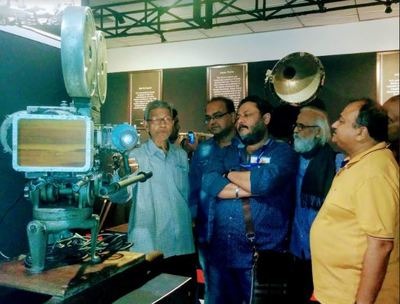Kolkata :
The camera which Subrata Mitra used for shooting ‘Pather Panchali’ triggered many memories for cinematographers – both veteran and young – when they dropped by at the ‘Looking Thru’ exhibition organised on the sidelines of the 23rd Kolkata International Film Festival. Inaugurated by director Prakash Jha, the exhibition is a priceless archive for global cinema.
“The exhibits include camera equipment used by directors like Lumiere Brothers, Satyajit Ray and Ritwik Ghatak and film students and the enthusiasts can learn a lot about our glorious history and how cinema evolved through its medium in the past century,” said principal secretary, Information and Cultural Affairs department Vivek Kumar.
Paying rich compliments to KIFF organisers for hosting such an exhibition, Jha said, “Truly, there was great passion in collecting all these and putting up such an exhibition. All film lovers of the city will be looking with eagerness at this. This adds a new chapter and will go a long way in understanding cinema,” Jha said.
One of the first exhibits on display – that was given by Anjan Bose of Aurora Film Corporation Pvt. Ltd – is a Bell & Howell 35 mm motion picture camera that was used in the silent era. US based Bell & Howell was founded in 1907 and was a manufacturer of motion picture machinery. Since 1909, this company used to make 35 mm motion-picture cameras. However, they stopped making motion-picture cameras from 1970s.
The next exhibit was the immensely popular camera in Europe. Called Super Parve, this camera was extensively used by Sergei Eisenstein and could record both sound and picture simultaneously in sound negative and picture negative formats. Director Abhijit Guha, who had come to watch this exhibition, mentioned that this camera was used for shooting Sukumar Dasgupta’s ‘Ora Thake Odhare’ and ‘Sadanander Mela’. “Both films had featured Uttam Kumar and Suchitra Sen,” Guha said.
The 35 mm Arriflex Blimp, which was capable of enclosing a 1000 ft magazine, also drew many visitors. The camera on display was used to shoot ‘Bhagini Nivedita’ and ‘Raja Rammohan’. Next on display was a Bell & Howells 1925 era Eyemo. Manufactured by the Bell & Howell Company of Chicago in 1925, it was the most popular, compact 35 mm camera that had a 100 ft capacity. Its small size made it a popular camera while filming during World War II and the Vietnam War. “During those days, it was difficult to film with heavy cameras. Hence, this camera became popular.
The 35 mm film size also was brought down to 16 mm and subsequently to 8 mm because of the needs during wartime filming. The 16 mm Maurer is another priceless camera in this collection. It was used for optical effects like dissolve, fade-in and fade-out. The Panavision is a later version of this camera,” said cinematographer Premendra Bikash Chaki.
Incidentally, this camera was so popular that the Appolo 11 spacecraft was equipped with a Maurer. History has it that the crew used this kind of camera to record lunar features from the lunar surfaces.
The Arriflex camera also had a special place in the exhibition. Based in Germany, the Arri group was founded in 1917. In 1937, Arri introduced the world’s first reflex mirror shutter in the Arriflex 35 camera. It has the ability to focus the image by eye through the viewfinder. Pointing at this camera, Chaki said, “This was used to shoot films like ‘Jalsaghar’ and ‘Jukti Tokko Aar Goppo’.”
The Bolex camera made by a Switzerland-based company also drew a lot of attention. Their 16 mm spring-wound is a popular introductory camera in film schools. In 1950s during the golden era of 3D film, Bolex offered a 3D stereo kit for their H-16 camera. Bolex 16 Pro and H-16 was technically very advanced. “This camera was used by Goutam Ghose. He had shot his award-winning documentary titled ‘Hungry Autumn’ with this,” Chaki said.
In 1952, Arri introduced the first professional 16 mm camera with a reflex-viewing system. In 1965, a self-blimped 16 mm camera was marketed: The Arriflex 16BL. “This camera was used by Goutam Ghose to shoot ‘Silk Route’,” Chaki added.
Even a Red digital camera donated by Swarup Biswas has also been on display. However, it was the Mitchell 35 mm camera that drew the maximum attention. That was not surprising since along with this camera was on display two working stills of Ray and Subrata Mitra shooting ‘Pather Panchali’. Gaur Karmakar, who had worked as an assistant cameraman in some of Ghatak’s films, explained: “We have shot ‘Komol Gandhar’ and ‘Subarnarekha’ with this very camera too.”
With many more stories unfolding behind the lens, it’s needless to say that viewers of KIFF will have a lot beyond movies as their takeaway from the cine-fest.
source: http://www.timesofindia.indiatimes.com / The Times of India / News> City News> Kolkata News / by Priyanka Dasgupta / TNN / November 11th, 2017
